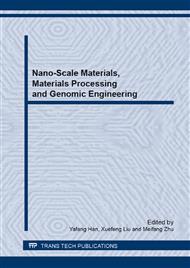[1]
H.-L. Yu, H.-Y. Bi, X.-H. Liu, L.-Q. Chen, N.-N. Dong, Behavior of inclusions with weak adhesion to strip matrix during rolling using FEM, J. Mater. Process. Technol. 209 (2009) 4274-4280.
DOI: 10.1016/j.jmatprotec.2008.11.004
Google Scholar
[2]
H.L. Yu, X.H. Liu, G.T. Lee, X.W. Li, H.D. Park, Numerical Analysis of Roll Deflection for Sendzimir Mill, Journal of Manufacturing Science and Engineering, 130 (2008) 011016.
DOI: 10.1115/1.2783256
Google Scholar
[3]
H.-L. Yu, X.-H. Liu, Thermal-Mechanical Finite Element Analysis of Evolution of Surface Cracks During Slab Rolling, Mater. Manuf. Processes 24 (2009) 570-578.
DOI: 10.1080/10426910902746895
Google Scholar
[4]
H.-l. Yu, X.-h. Liu, C.-s. Li, Y. Kusaba, Behavior of Transversal Crack on Slab Corner During V-H Rolling Process, Journal of Iron and Steel Research, International, 13 (2006) 31-37.
DOI: 10.1016/s1006-706x(06)60106-4
Google Scholar
[5]
E. Ervasti, U. Ståhlberg, Void initiation close to a macro-inclusion during single pass reductions in the hot rolling of steel slabs: A numerical study, J. Mater. Process. Technol. , 170 (2005) 142-150.
DOI: 10.1016/j.jmatprotec.2005.04.117
Google Scholar
[6]
E. Parteder, K. Zeman, H. Du, R. Grill, Recalculation of Flow Stresses from Industrial Process Data for Heavy Plate Rolling Using a 2D Finite Element Model, Steel Res. Int. , 83 (2012) 124-130.
DOI: 10.1002/srin.201100179
Google Scholar
[7]
Z.Y. Jiang, W.P. Hu, X.H. Liu, G.D. Wang, Computational strategies for some technical issues in the simulation of the strip rolling processes using rigid–plastic FEM, Commun. Numer. Methods Eng. , 16 (2000) 601-613.
DOI: 10.1002/1099-0887(200009)16:9<601::aid-cnm358>3.0.co;2-6
Google Scholar
[8]
M.A. Cavaliere, M.B. Goldschmit, E.N. Dvorkin, Finite element simulation of the steel plates hot rolling process, Int. J. Numer. Methods Eng. , 52 (2001) 1411.
DOI: 10.1002/nme.262
Google Scholar
[9]
K. Mori, K. Osakada, Finite element simulation of three-dimensional deformation in shape rolling, Int. J. Numer. Methods Eng. , 30 (1990) 1431-1440.
DOI: 10.1002/nme.1620300807
Google Scholar
[10]
H.-l. Yu, X.-h. Liu, H.-y. Bi, L.-q. Chen, Deformation behavior of inclusions in stainless steel strips during multi-pass cold rolling, J. Mater. Process. Technol. , 209 (2009) 455-461.
DOI: 10.1016/j.jmatprotec.2008.02.016
Google Scholar
[11]
F.W. Bach, D. Bormann, M. Rodmann, H. von Senden genannt Haverkamp, Friction and Temperature Development in the Hot Roll Cladding Process, Steel Res. Int. , 81 (2010) 48-54.
DOI: 10.1002/srin.200900114
Google Scholar
[12]
M. Pietrzyk, R. Kuziak, Validation of a Model of Plastic Deformation of C-Mn Steels in the Two-Phase Temperature Region, Steel Res. Int. , 80 (2009) 767-778.
DOI: 10.1002/srin.201100248
Google Scholar
[13]
M. Brinkmeier, U. Nackenhorst, Simulation and Measurements of Rolling Tire Dynamics, Pamm, 6 (2006) 293-294.
DOI: 10.1002/pamm.200610128
Google Scholar
[14]
A. Kainz, K. Krimpelstaetter, K. Zeman, Inconsistencies in Plane-strain Elasto-plastic Rolling Simulations, Pamm, 6 (2006) 387-388.
DOI: 10.1002/pamm.200610174
Google Scholar
[15]
L. Hong-Min, J. Dan, W. Ying-Rui, Strip layer method for simulation of the three-dimensional deformations of plate and strip rolling, Commun. Numer. Methods Eng. , 20 (2004) 183-191.
DOI: 10.1002/cnm.659
Google Scholar
[16]
L. Neumann, H. Aretz, R. Kopp, M. Goerdeler, G. Gottstein, Finite Element Simulation of an Industrial hot Rolling Schedule of Aluminium using Integrated Microstructure Models, Adv. Eng. Mater. , 5 (2003) 815-818.
DOI: 10.1002/adem.200300361
Google Scholar
[17]
D. Raabe, Simulation and Experimental Examination of the Evolution of Orientation Gradients in Single Grains during Rolling of Body Centered Cubic Polycrystals, physica status solidi (b), 181 (1994) 291-299.
DOI: 10.1002/pssb.2221810203
Google Scholar
[18]
T. Leffers, Computer simulation of the plastic deformation in face-centred cubic polycrystals and the rolling texture derived, physica status solidi (b), 25 (1968) 337-344.
DOI: 10.1002/pssb.19680250133
Google Scholar
[19]
A. Obereder, A. Kainz, Fast Numerical Simulation of 3D Steady-State Hot Rolling Processes by Utilizing Diffpack and Deform, Pamm, 4 (2004) 362-363.
DOI: 10.1002/pamm.200410162
Google Scholar
[20]
H.L. Yu, X. Liu, G.T. Lee, Contact element method with two relative coordinates and its application to prediction of strip profile of a sendzimir mill, ISIJ Int. , 47 (2007) 996-1005.
DOI: 10.2355/isijinternational.47.996
Google Scholar


